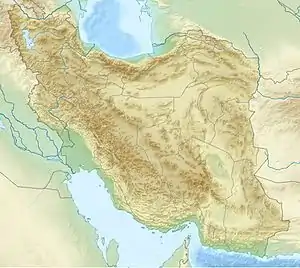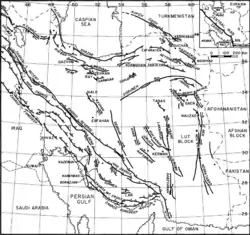 Tehran | |
| UTC time | 1957-07-02 00:42:26 |
|---|---|
| ISC event | 886779 |
| USGS-ANSS | ComCat |
| Local date | July 2, 1957 |
| Magnitude | 6.6–7.1 Mw |
| Depth | 15 km (9 mi) |
| Epicenter | 36°16′37″N 52°46′41″E / 36.277°N 52.778°E[1] |
| Type | Strike-slip |
| Areas affected | Iran |
| Total damage | US$25 million |
| Max. intensity | IX (Violent) |
| Casualties | 1,500 killed |
The 1957 Sangchal earthquake struck northern Iran's Mazandaran province on 2 July 1957. It had a moment magnitude of 6.6 or 7.1 (Mw ), focal depth of 15 km (9.3 mi),[1] and maximum Modified Mercalli intensity of IX (Violent).[2] It devastated many communities in the Alborz Mountains and caused an estimated 1,500 fatalities. Damage was estimated at US$25 milion.
Tectonic setting
The Iranian plateau is a region of highly deformed crust wedged between the Arabian Plate to the southwest and Eurasian Plate to the northeast. Crustal deformation is dictated by the 22 cm (8.7 in)/yr oblique-convergence between the two tectonic plates. Deformation is accommodated by reverse and strike-slip faulting. In northern and southern Iran, thrusting allows convergence through crustal thickening to take place. Most of the convergence is accommodated along fold and thrust belts of the Zagros, Alborz, Kopet Dag mountains, and in eastern Iran, where seismicity is high. Seismicity in the central plateau is low due to its geology consisting of rigid and aseismic tectonic blocks.[3]
Earthquake

The earthquake was the result of shallow thrust faulting along the Larzaneh Fault, a shallow south-dipping thrust fault in the Alborz Mountains. The mainshock ruptured across a 50 km (31 mi) × 25 km (16 mi) area. It is the second largest instrumentally recorded earthquake in the mountains, behind the 1990 Manjil–Rudbar earthquake. The earthquake beneath the mountains occurred in a region of northwest–southeast trending reverse faults; near the interconnection of two antithetic reverse faults where the western Larzaneh Fault terminates. The fault links to another thrust fault via a linkage fault dipping southwest and extending to the northwest.[3]
No coseismic surface faulting was associated with the earthquake and there were no anomalies in fumarolic activity on Mount Damavand despite its epicenter within 100 km (62 mi) of the volcano.[4] However, some fault movement was observed along the Amir Fault Zone, a south-dipping reverse fault. Fresh cracks were reported along a road that crosses the fault after the earthquake. There were unconfirmed reports of large fissures measuring several kilometers long in the mountainous area, north of Sang Chal. Nicholas Ambraseys also documented 3 km (1.9 mi) of surface faulting which were not coseismic. These cracks were explained as triggered landslides or other natural events other than faulting.[5]
Impact
The meizoseismal area was located between the Haraz and Talar rivers; encompassing the dehestans of Band Pay, Beh, Dala Rustaq and Chalav. There, around 120 villages were levelled and 1,500 deaths were recorded. The villages of Sang Chal, Nandal, Chaliyasar, Nasal, Andavar and Pardimeh were the hardest-hit. In Burun, Varzaneh, Shanguldeh, Nal and Dinan, rockfalls and landslides caused further devastation. Rivers and streams were dammed by falling rocks and landslides; the Haraz River near Aliabad was blocked by a 20 m (66 ft) high and 1 km (0.62 mi) long dam which formed a reservoir. There were few engineering infrastructures in the region; the only reported damage was along Haraz road, which was minimal. The abudments of an 80 m (260 ft) long masonry arch bridge sunk, and its deck cracked. The lining of a tunnel linking Kuhrud and Bayjan was severely cracked and its haunch sheared. Minor damage was observed at a tunnel near Nur and on a wooden bridge in Aliabad.[4]
Damage beyond the meizoseismal area was less severe but widespread. The severity of damage decreased more dramatically with distance towards the northwest and southeast compared to the northeast and southwest. Damage was reported as far as Pul-i Safis, Shiragh and to the Kaslian River. At Utu, near the Kaslian River, several homes collapsed. Caved roofs were reported in Polur and Fasham while in Tehran, some homes were damaged. Damage to buildings extended as far southeast as Firuzkuh. To the northwest, at Qaemshahr and Sari, some modern constructions were damaged. An imamzadeh at Vāneh and the Emamzadeh Hashem Shrine were heavily damaged.[4]
See also
References
- 1 2 ISC (27 June 2022), ISC-GEM Global Instrumental Earthquake Catalogue (1900–2009), Version 9.1, International Seismological Centre
- ↑ National Geophysical Data Center / World Data Service (NGDC/WDS) (1972), Significant Earthquake Database (Data Set), National Geophysical Data Center, NOAA, doi:10.7289/V5TD9V7K
- 1 2 Ansari 2021.
- 1 2 3 Ambraseys & Melville 1982, p. 93–94.
- ↑ Tchalenko 1973, p. 310–320.
Sources
- Ambraseys, N. N.; Melville, C. P. (1982). A History of Persian Earthquakes. Cambridge University Press. pp. 93–94. doi:10.1016/B978-0-444-63292-0.00009-0. ISBN 9780521021876.
- Tchalenko, J. (1973). "Recent destructive earthquakes in the CentraL Alborz (Iran)". Annals of Geophysics. 26 (2–3). doi:10.4401/ag-5015.
- Ansari, S. (2021). "Role of fault structural heterogeneity in nucleation location of the Mw ≥ 7 Earthquakes in Iran". Environmental Earth Sciences. 80 (730). Bibcode:2021EES....80..730A. doi:10.1007/s12665-021-10042-9. S2CID 239771196.
External links
- The International Seismological Centre has a bibliography and/or authoritative data for this event.